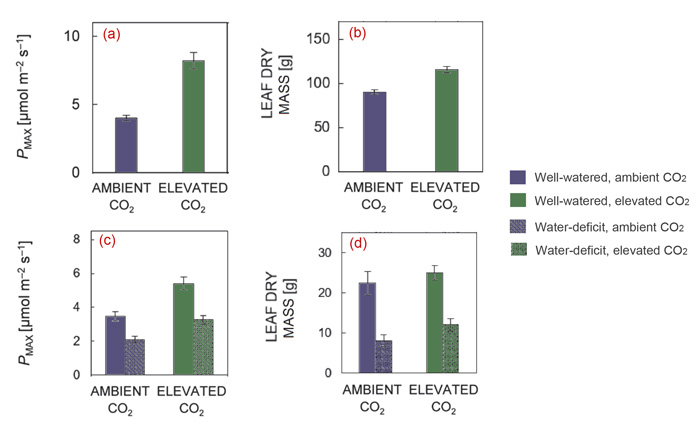| Tweet | Follow @co2science |
Paper Reviewed
Lahive, F., Hadley, P. and Daymond, A.J. 2018. The impact of elevated CO2 and water deficit stress on growth and photosynthesis of juvenile cacao (Theobroma cacao L.). Photosynthetica 56: 911-920.
Cacao (Theobroma cacao) is an important tree species grown as a cash crop in tropical regions of the world, particularly West Africa, Central and South America and South-East Asia. Its beans are utilized in the production of cocoa, cocoa butter and chocolate. Yet, despite its monetary and culinary importance, little research has been conducted to determine how this perennial plant might respond to increasing atmospheric CO2 concentrations and predicted changes in climate. That objective, became the focus of a new study by Lahive et al. (2018), who set out to examine "the effects of elevated CO2 concentration and water deficit on [the] growth and photosynthesis of juvenile cacao."
To accomplish their work, the three scientists conducted two experiments. In the first, four-month-old cacao plants were grown in a controlled-environment setting at a greenhouse facility located at the University of Reading, UK. There, under adequate water conditions, plants were exposed to either ambient (~400 ppm) or elevated (~ 730 ppm) atmospheric CO2 levels over a period of 154 days. In the second experiment, the researchers added another variable to the mix, exposing half of the plants in each CO2 treatment to adequate levels of soil moisture (average content of 34.4%) and half to water-deficit conditions (average soil moisture content of 16.4%). The second experiment lasted 90 days.
Their results indicated, not surprisingly, that cacao plants grew better under well-watered conditions than under water-deficit conditions. However, as the authors note, the "[observed] reduction in a number of growth parameters (e.g., leaf area, leaf dry mass) due to water deficit was smaller in plants grown at elevated CO2 compared to those grown at ambient CO2." Indeed, elevated CO2 significantly enhanced phosynthetic- and other growth-related parameters of cacao, regardless of soil moisture levels (see figure below). Light-saturated photosynthetic rate under well-watered conditions, for example, increased by 105% in the first experiment and by approximately 56% under both well-watered and water deficit conditions in the second. Stem diameter, leaf area, fresh and dry mass and plant intrinsic and instantaneous water use efficiency also benefitted from, and were enhanced by, elevated CO2. Another key finding was that elevated CO2 improved the nitrogen-use efficiency of the plants, which observation, according to the authors, "could be beneficial in the nutrient depleted soils in many cacao growing regions in West Africa" by increasing growth and yields under the same or dwindling levels of nitrogen availability.
In commenting on these important findings, Lahive et al. conclude that the "positive effect of CO2 may ameliorate growth reductions caused by water limitation in the future," which "could potentially improve pod yields [of cacao] by supporting a larger number of pods per tree." And that is sweet news indeed for the farmers who grow and the consumers who utilize cacao for its confectionary delights!

Figure 1. Growth responses of well-watered and water deficit-treated cacao plants grown at ambient and elevated CO2. Data are from two experiments conducted for 154 (Panels A and B) and 90 (Panels C and D) days. Adapted from Lahive et al. (2018).




